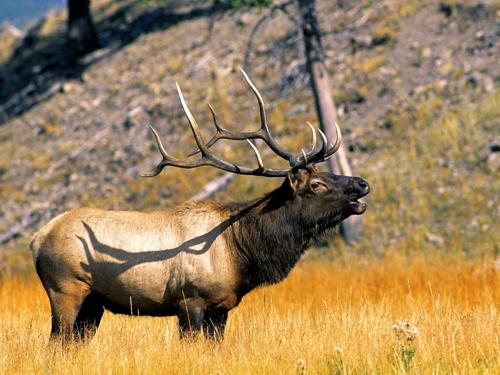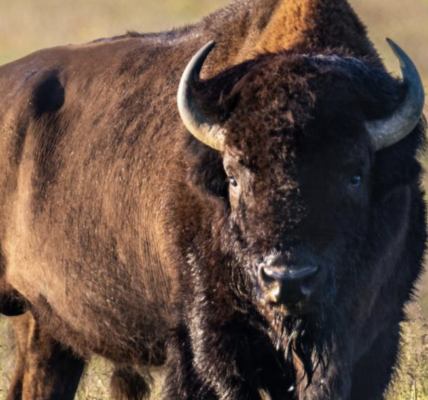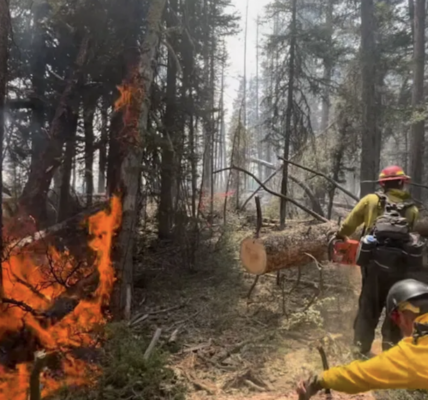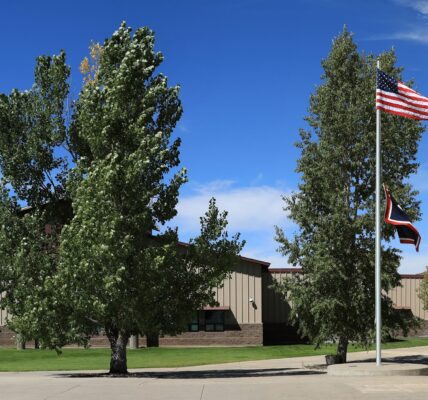By Mike Koshmrl
Jackson Hole News&Guide
Via Wyoming News Exchange
JACKSON — Save for a decade’s worth of mild winters, the National Elk Refuge has spread out hay or alfalfa to nourish gathering wapiti for the past 107 years.
But the marching orders prescribed by a now 12-year-old federal plan are to scale back this longstanding and controversial supplemental feeding program so that the Jackson Elk Herd will generally live naturally off the land.
Progress toward that goal has been scant. A record proportion of the Jackson herd has been drawn to the refuge in some recent years as the elk are redistributing. Overall numbers of the tawny ungulates have climbed in the dozen years that have passed since the National Elk Refuge, Grand Teton National Park and the Bridger-Teton National Forest signed off on a document that guides the future of the Jackson elk and bison herds.
As long as four years ago Elk Refuge staff told the News&Guide that a supplementary “step-down plan” that’s supposed to identify strategies to wean elk off feed was about to come out. Fast forward to the present, and that document remains snagged by bureaucracy and politics. The delays have drawn a lawsuit from environmental groups worried that the effects of recently arrived chronic wasting disease could be exacerbated by a continuation of business-as-usual elk feeding.
Though not officially out, a draft of the feeding-reduction plan has landed in nongovernmental in-boxes thanks to Freedom of Information Act requests. And that unpublished draft, which dates to December 2017, is still in essence the same plan that’s on the table today, Elk Refuge Manager Brian Glaspell told the News&Guide last month. That plan outlines over dozens of pages how exactly the refuge intends to ease away from its century-old elk feeding program.
“Our focus is on the health of the herd,” Glaspell said. “Feeding is a tool. What we want to do is create a set of conditions where using that tool is rarely necessary.”
Nuts and bolts
The “principal strategy” that’s in the works, according to the draft plan, is delaying when alfalfa pellets begin hitting the ground.
The point of a delay is to reduce the chance that elk wintering on natural slopes, bottomlands and the Wyoming Game and Fish Department’s three Gros Ventre River drainage elk feedgrounds discover feeding equipment on the 24,700-acre refuge bordering Jackson.
“Because elk use of feeding grounds is a learned behavior, over time this could increase the proportion of elk that winter on native winter range, reduce the number of elk that move from the Gros Ventre drainage to [the refuge] and decrease the [refuge] wintering elk population,” the unpublished draft plan says. “The resulting shift in elk distribution would allow us to achieve the 5,000 elk objective for refuge.”
Other objectives contemplated in the refuge’s guiding 2007 plan — which the step-down plan tiers off of — have been met, or progress has been made. The population of the Jackson Bison Herd, for example, has been trimmed by hunting by more than half and now hovers near its 500-animal goal. Massive multi-million-dollar irrigation systems meant to provide elk with more forage have been built out, another goal met. Teton park has also made some progress converting relic pastureland back to native sagebrush-studded grassland more useful to elk, another element of the 12-year-old plan.
The failure to meet the numeric elk goals and curb artificial feeding stems largely from a fundamental redistribution of the Jackson herd. During the winter of 2017-18 essentially the entire 11,000-animal herd — or 97 percent — gathered on the refuge or immediately adjacent forest foothills. When the guiding bison and elk plan was being crafted in the early 2000s, the proportion of elk in these areas relative to other Jackson Hole winter ranges was about half that.
Dialing up hunting pressure isn’t considered a viable standalone tool to get to 5,000 refuge elk, because the overall herd is at its desired size of 11,000 animals. Decreasing that objective is up to the state of Wyoming, and so the refuge’s draft step-down plan doesn’t contemplate taking that action. Still, hunting seasons would be tweaked, according to the document, including the possible allowance of bow hunting near the highway and town, limited bull elk hunting and a one-week extension of the season.
Another strategy identified is similar to the “principal strategy” of delaying the onset of feeding. On the opposite end of the feeding season, the step-down plan calls for terminating the alfalfa handouts one week earlier than the average termination date today.
The truncated feeding season would not be an unregulated grand experiment. Widespread starvation will not be permitted under the step-down plan terms. Rations of 8 to 12 pounds per day per elk are not positioned to change, and a threshold is baked into the plan to ensure that almost all animals make it through the winter.
Wintertime die-offs are the natural order in a high-elevation environment like Jackson Hole. The mortality that would result here in the absence of feeding would likely be exacerbated by migration routes to more fertile and less-snowy wintering grounds that have been severed and lost to history.
Some 28 percent of Yellowstone National Park elk calves died during winter in a study cited by the step-down plan. The document aspires to keep death rates much, much lower than that. Currently, 1% to 2% of refuge elk die in a given winter. Mortality would be capped at 5%, and if the herd started succumbing at rates that exceeded that level then steps would be taken to keep more elk alive, the plan says.
Much of the planning document concerns issues outside the National Elk Refuge’s jurisdiction, such as how to deal with elk that are destined to head for private lands in search of cut hay and more easily accessible grasses.
Conservation easements on ranch land would be targeted, and state and federal agencies would bring on seasonal biological and conflict-mitigation technicians to monitor the progress and help see the step-down plan through.
A budget appended to the draft document even calls for setting aside $6,000 a year for helicopters to haze elk off cow pastures. The big-ticket item listed is leased private lands and secured conservation easements, together forecasted to cost “above $1 million” annually.
Regardless of the built-in safeguards, the step-down plan targets a significant reduction in the volume of alfalfa being dispensed: cutting it in half. The refuge will consider the objective of transitioning elk to freestanding forage met when the three-year running average of elk and bison “fed days” has fallen to 50% or less of the baseline number for five years in a row.
“This level was chosen to define success,” the draft plan states, “because it indicates that elk and bison will predominately be foraging on freestanding natural and cultivated plants on [the refuge] and adjacent winter ranges rather than on supplemental feed.”
Dim reviews
One environmental activist who has watchdogged the National Elk Refuge for years and read the draft plan said it’s too noncommittal and is destined to fail. It was Western Watersheds Project staffer Jonathan Ratner who acquired the step-down plan through a records request, and he had a decidedly dim and sarcastic critique.
“For being a completely spineless and worthless piece of paper that does not solve the problem at hand,” Ratner said, “it’s actually pretty good.”
Correspondence secured through Ratner’s records request provides some insight into why the step-down plan is held up. The plan remains in some stage of review at the U.S. Fish and Wildlife Service’s regional office in Denver, and its potential release is out of the hands of managers who oversee the property.
“It’s not my call,” Glaspell said.
Days after sending a working draft of the step-down plan to Fish and Wildlife’s Denver office in early 2018, Glaspell was asked to run it by the Wyoming Game and Fish Department, according to emails secured through FOIA. The boss of the state agency at the time, Scott Talbott, was not responding to phone calls, so the refuge manager wrote to Fish and Wildlife’s regional refuge system chief, Will Meeks, that he instead would work through Brad Hovinga, who supervises Game and Fish’s Jackson Region.
“I’ll try to pin him down on what is remaining in the step down plan that the state may find objectionable,” Glaspell wrote in the 18-month-old email. “It’s my understanding that we have, through successive iterations of the plan, made numerous changes at the state’s request so that it is now (by some opinions) virtually toothless.
“I’m not sure there are any teeth left to pull,” he wrote, “but we’ll see what Brad has to say.”
Despite the frustrated tone, Glaspell said in an interview that he has had a healthy and productive relationship working with Game and Fish to amend the internal draft.
“They were at the table at every part of the planning process,” he said, “and they’ve been good partners.”
Two weeks after sitting down with the News&Guide, Glaspell announced that he took a promotion and would be moving to a deputy job overseeing all of the U.S. Fish and Wildlife Service’s Alaskan wildlife refuges. The July departure, he said, had nothing to do with the politics and institutional inertia that has kept the step-down plan from being released since he took the job in early 2017.
Meeks, who evidently is working on seeing the step-down plan through, declined an interview request, citing ongoing litigation.
That lawsuit, which asks a judge to force the release of the step-down plan, was brought by Earthjustice in March on behalf of the National Wildlife Refuge Association, Defenders of Wildlife and the Sierra Club. One driving factor for the suit was “severe disease threats,” and it describes the anticipated effects of chronic wasting disease, a lethal and incurable cervid sickness that showed up in a buck mule deer road-killed not far from the refuge boundary last fall.
“The Fish and Wildlife Service’s mission is to manage for healthy habitat and healthy wildlife,” Sierra Club employee and elk feeding critic Lloyd Dorsey told the News&Guide when the lawsuit was filed. “They’ve got hoof rot on the refuge, which is deadly. They’ve got brucellosis on the refuge, which makes elk and bison chronically ill. And now CWD is in the valley, which is always lethal for deer, elk and moose.”
Earthjustice attorney Tim Preso, who manages the firm’s Bozeman, Montana, office, said that Fish and Wildlife has not yet responded to the complaint and that a federal judge granted the agency an extension to do so. Federal attorneys now have until July 26 to submit a written defense, he said. Asked his opinions of the draft step-down plan’s contents this week, Preso withheld judgment.
“The problem right now is there’s no plan at all,” Preso said. “There are just these internal drafts. We’re going to take a close look at the plan if we can get it out the door because we don’t think that tentative measures are what’s needed at this time.”
“What we need,” he said, “is some leadership from the U.S. Fish and Wildlife Service.”





